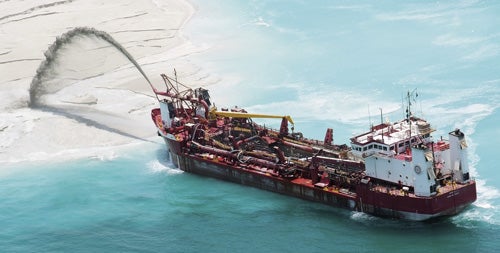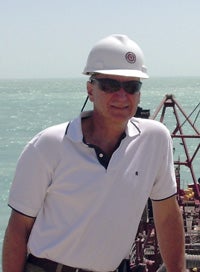Dredging up Global Solutions

It was February 1978 when civil engineering major David Simonelli ’78 attended a presentation on dredging by recent grad Jim Beattie ’77, who was wearing shorts and sporting a great tan.
 Sold on the idea of working abroad in warmer climates, like recruiter Beattie, Simonelli and classmates Dan Urso and Dave McCarthy accepted job offers from Oak Brook, Illinois-based Great Lakes Dredge & Dock Company (GLDD). “Engineers were in high demand,” Simonelli recalled. “ I had many offers, but Great Lakes gave me the opportunity to work on huge port projects throughout the world.”
Sold on the idea of working abroad in warmer climates, like recruiter Beattie, Simonelli and classmates Dan Urso and Dave McCarthy accepted job offers from Oak Brook, Illinois-based Great Lakes Dredge & Dock Company (GLDD). “Engineers were in high demand,” Simonelli recalled. “ I had many offers, but Great Lakes gave me the opportunity to work on huge port projects throughout the world.”
The rest, as they say, is history. Simonelli’s 34-year tenure with the country’s largest provider of dredging services is akin to Amazing Race episodes that depict contestants crisscrossing the globe in heated competition.
“I realized that URI taught me to solve problems—to break them down into manageable components and think through viable solutions.”
— David Simonelli
Joining GLDD as a field engineer, Simonelli hit the ground running. After a few months of learning the basics on a project in New York, he found himself on a PanAm flight to Dubai, United Arab Emirates, to work on Jebel Ali: “The Sheikh envisioned this port becoming the busiest in the world,” said Simonelli. The sheik’s premonition was correct. With 67 berths, Jebel Ali is the biggest port in the Middle East and the world’s largest man-made port.
GLDD’s success in Dubai not only helped the company establish a firm stronghold in the Middle East, it also successfully tested Simonelli’s aptitude for large, complex global projects. His subsequent assignments included a port improvement project in Mombassa, Kenya; the construction of a coal export facility in Colombia; and a large Middle Eastern reclamation project that brought the Simonelli family to Qatar for four years.
“It was an incredible experience. We lived in a compound with other expatriates associated with companies like Mobil Oil, Occidental, and Qatar Gas. Together, we were like family,” remarked Simonelli, whose responsibilities expanded along with the scope of the projects that he undertook. Advancing steadily through the engineering ranks, in 2010 Simonelli was named president of dredging operations, overseeing a Dredging Operations Group that includes estimating, engineering, plant and equipment, and domestic and foreign operations.
In this role, Simonelli ensures that GLDD’s state-of-the-art fleet—the largest and most diverse in the U.S. industry with more than 200 specialized vessels—is flexible enough to meet the nation’s needs of deepening and maintaining its ports and waterways. “We are constantly upgrading and modifying our specialized equipment, for example, to dredge the rock in New York Harbor more efficiently while also meeting the EPA’s Tier II Emission Standards,” he said.
Moreover, Simonelli is concentrating on guiding GLDD toward achieving its five-year goal of doubling its size by entering new international markets and expanding the company’s menu of services: “Early last year, we acquired Matteson Dredging in Iowa. Its focus is on the inland river systems, a market we were not active in. Now we have the tools to operate in shallower waters.
“We’ve also developed an environmental arm through a joint venture with Belgium-based contractor DEC. This partnership will allow us to participate in the removal and treatment of contaminated sediments and soils on such projects as the Hudson River PCB cleanup.”
Simonelli noted that while the Middle East continues to be a very important market for the company’s services, last year’s Arab Spring unrest temporarily interrupted operations there in March 2011. Division Manager and V.P. John O’Brien ’79 relocated staff and implemented security measures to ensure the safety of the company’s employees and assets.
In a twist of irony, the uprising served as the genesis for the $57 million East Hidd Reclamation Housing Project that a GLDD Joint Venture was awarded last November. “Shia protesters decried the lack of housing in the capital city, Manama, so this project that reclaims 618 acres of the Arabian Gulf will create suitable land for that population to move to.”
In the U.S., domestic beach nourishment and coastal reclamation projects are underway to protect the vulnerable shorelines along the East and Gulf coasts. GLDD’s hopper and cutter suction dredges mine sand from offshore borrow sites and hydraulically transport the material to shoreline locations: “In the Gulf of Mexico, we are creating barrier islands to protect Louisiana’s coastline from natural erosion and storm damage. When Hurricane Katrina swept through the area, the levee system failed, causing mass destruction. The lack of natural defenses to absorb the energy compounded the problem. Our work is replacing thousands of acres of lost marshland.”
Replacing jobs lost in the Great Recession is also among the advantages of dredging activity. Port expansions are expected to jumpstart the economy. East Coast ports hoping to capitalize on the Panama Canal expansion—scheduled for a 2014 completion—are racing to deepen their access channels and berths in order to accommodate the larger, deeper draft vessels transiting the expanded canal.
“Deepening projects are in the planning stages for the ports of Charleston, Savannah, and Miami; this will provide significant opportunities for utilization of the company’s dredging fleet,” said Simonelli. “These deeper ports have significant flow down effects. Larger ships capable of accessing American ports reduce the shipping costs of imports and exports. Increased trade means more jobs loading and unloading. Warehouses are built to store goods. Roads and tunnels are improved to expedite the transport of goods. I often say ‘it all starts with dredging!’”
Or, in Simonelli’s case, it all began with a presentation by an enthusiastic alum with a mid-winter tan. While travel to exotic locales was appealing, Simonelli says it was his URI education that inspired him to remain with GLDD: “I majored in structural engineering. After three years with GLDD, I was concerned about losing that skill set, and I struggled with that possibility.
“That is when I started to understand the value of my education. I realized that URI taught me to solve problems—to break them down into manageable components and think through viable solutions. And that’s what I was doing—daily tasks like quantity calculations and production analysis with multinational teams of engineers supporting dredging vessels on projects around the world.
“It gives me great pleasure to recruit from URI. Engineering graduates have the skills we need, and what’s more, given URI’s location, they are comfortable working on the water.”
By Maria V. Caliri ’86, M.B.A. ‘92
 Home
Home Browse
Browse Close
Close Events
Events Maps
Maps Email
Email Brightspace
Brightspace eCampus
eCampus


